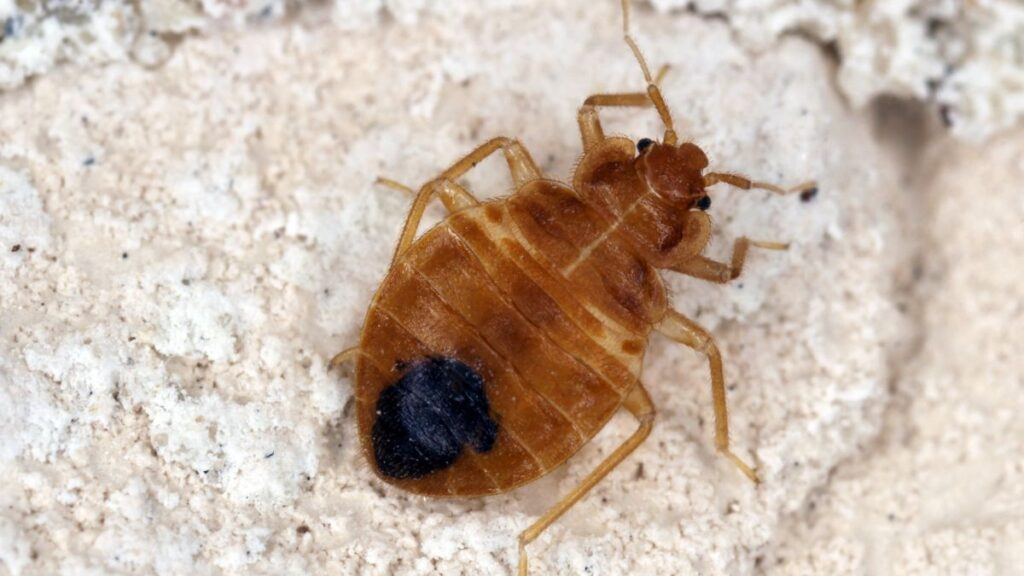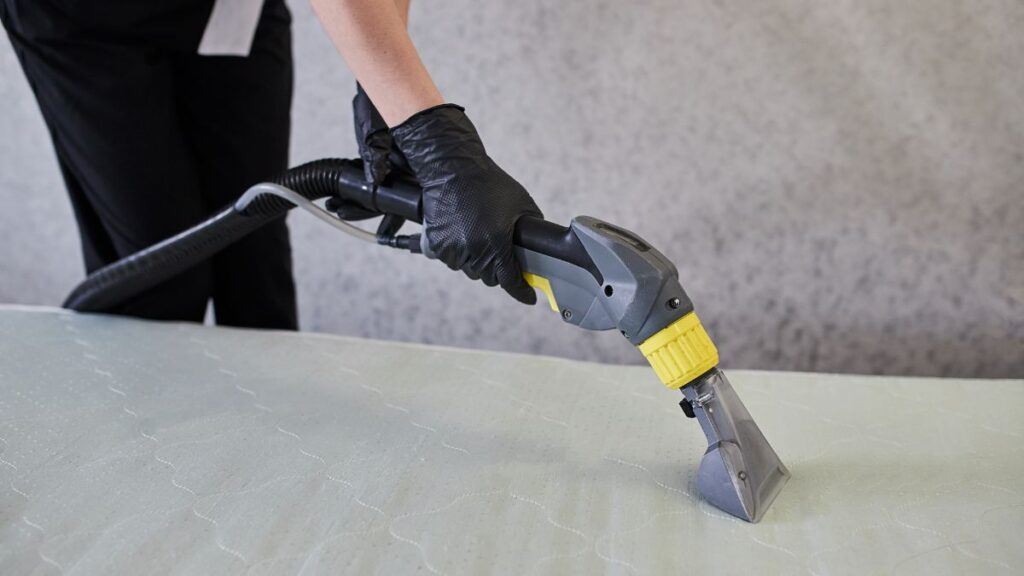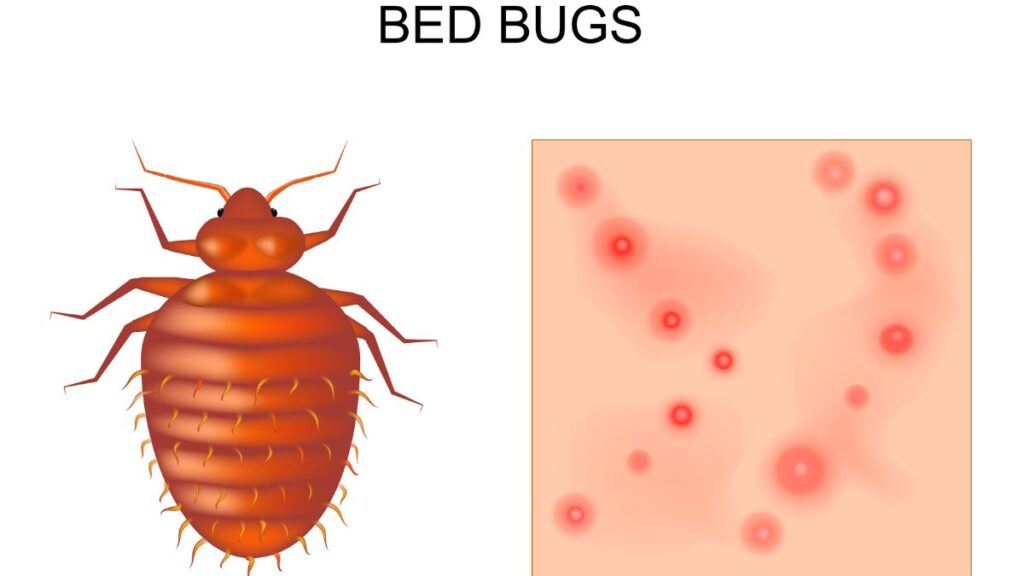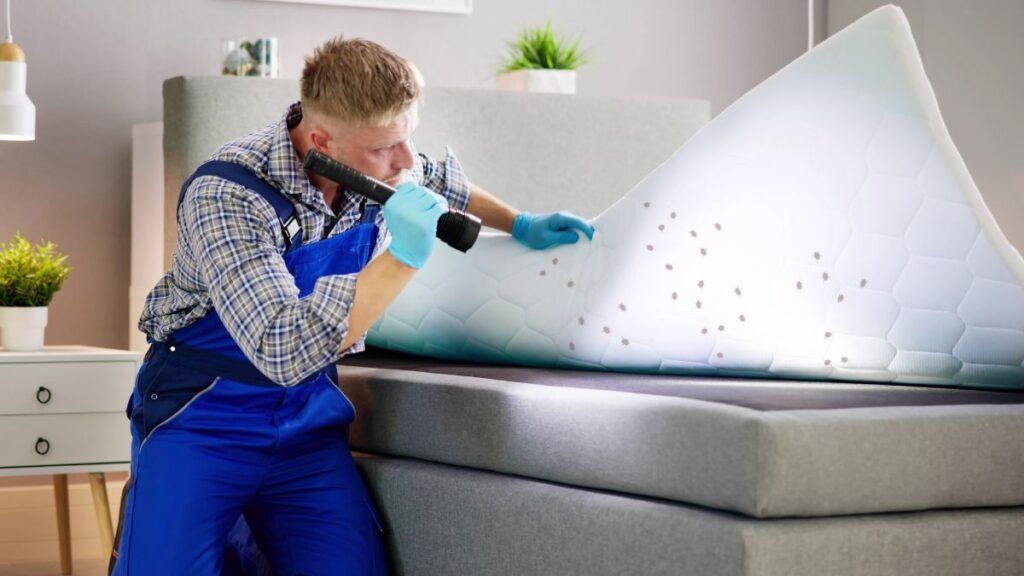The question of whether bed bugs can live in cat litter is intriguing, given their known adaptability and resilience in various environments.
However, bed bugs typically prefer environments with easy access to their primary food source: human blood.
They are drawn to warmth, carbon dioxide, and certain textures, such as fabric and wood, absent in cat litter.
Cat litter, usually made of clay, silica, or biodegradable materials, does not provide the warm, carbon-dioxide-rich environment bed bugs seek for harborage.
The texture and conditions of cat litter are not conducive to their survival or breeding.
The short answer is no. Bed bugs can’t live in cat litter, which does not offer an ideal habitat.
While bed bugs can adapt to various environments, their preferences and biological needs suggest that cat litter is not a suitable living space for these pests.
Understanding Bed Bugs and Their Habitats

Bed bugs are adaptable pests with specific characteristics that favor human environments. Their presence in homes and around pets can raise concerns about the extent of their habitat preferences.
Characteristics of Bed Bugs
Cimex lectularius, commonly known as bed bugs, are small, nocturnal insects from the family Cimicidae. They possess a flat, oval body measuring about 4 to 5 millimeters in length when unfed.
Bed bugs are reddish-brown and can survive for several months without a meal. They prefer human blood, which they extract from their hosts mainly at night.
Signs of bed bug infestations include sightings of live bed bugs, exoskeletons after molting, small blood spots on bedding, and a sweet, musty odor.
Common Habitats for Bed Bugs
Bed bugs are expert hitchhikers and can be found worldwide, especially in places with a high rate of occupant turnover, such as hotels, hostels, and apartments.
They tend to hide in small crevices near where humans sleep, including mattress seams and bed frames, as these locations provide easy access to their human hosts at night.
Despite their name, bed bugs can inhabit various locations beyond beds, such as furniture, luggage, clothing, and other personal belongings.
The insects seek out tiny cracks and crevices that can remain concealed during the day.
Bed Bugs in Relation to Pets
While bed bugs prefer human blood, they may occasionally bite pets if human hosts are unavailable.
However, unlike fleas and ticks, bed bugs do not live on pets or within their fur.
Since they are not adapted to navigate through hair, they are unlikely to infest areas such as cat litter or bedding designed for pets.
Pet owners should be vigilant and watch for bed bug bites on pets, which can present as small red bumps similar to those found on humans, and should also inspect pet beds and areas where pets sleep as part of a broader bed bug control strategy.
Relationship Between Bed Bugs and Cat Litter

Bed bugs are pests commonly found in human dwellings. These insects typically feed on human blood, but they have been known to bite pets when humans are unavailable.
Their presence in a home does not always correlate with a lack of cleanliness. However, it is less common to find bed bugs living in cat litter or a cat’s litter box.
Bed Bug Habits:
- Prefer fabric and wood
- Avoid smooth surfaces
- Active mainly at night
Cat Litter and Litter Boxes:
- Usually consist of clay, silica, or biodegradable substances
- Typically, they do not provide a suitable environment for bed bugs
Unlike bed bugs, which prefer the warmth of a bed or other fabric-based areas, cat litter areas are not ideal for survival. Litter boxes often have smooth surfaces, which bed bugs typically avoid.
Pet Concerns:
- Bed bugs may hitch a ride on a pet’s fur
- Pets can indirectly transport bed bugs to different areas
- It’s advisable to check the pet’s bed and surrounding areas
Although bed bugs may temporarily be on a cat’s fur, they do not tend to infest the fur as fleas or ticks do.
Regularly cleaning a cat’s bed and the areas around a litter box can help minimize the chances of bed bugs spreading within the household.
Prevention Methods for Bed Bug Infestations

Preventing bed bug infestations is crucial to maintaining a clean and safe home environment.
Focus on early detection and regular maintenance to thwart bed bugs’ ability to establish a foothold in your living space.
Regular Cleaning and Vacuuming
Frequent vacuuming is key to removing bed bugs and their eggs from carpets, floors, and furniture.
Ensure the vacuum cleaner has a HEPA filter to trap insects effectively. After vacuuming, immediately dispose of the vacuum bag or empty the canister outside to prevent re-infestation.
- Areas to Vacuum: Beds, sofas, curtains, and other furniture
- Frequency: Perform vacuuming weekly or more often if bed bugs are suspected
Using Protective Covers
Encasing mattresses and box springs in protective covers explicitly designed for bed bug prevention can help to detect and isolate bed bugs.
Such covers are often made of durable materials that bed bugs cannot penetrate and feature tight zippers that prevent escape.
- Material: Prefer covers that are breathable yet strong
- Installation: Ensure all creases and folds are checked before zipping
Bed Bug Deterrents
Several deterrents, such as diatomaceous earth and silica gel, dehydrate and kill bed bugs, should be considered.
Apply these powdery substances around potential entry points and hiding spots.
Heat treatment is also effective, as bed bugs cannot survive in extreme heat.
- Substance Application: Sprinkle around bed legs and furniture
- Heat Treatment: Utilize high heat, like steam cleaners, for infested items
| Deterrents | Application Method | Use Cases |
|---|---|---|
| Diatomaceous Earth/Silica Gel | Sprinkle as directed | Around bed frames and in cracks |
| Total Release Foggers | Follow label instructions | Only in unoccupied spaces |
| Heat Treatment | Apply high heat with devices | Beddings, curtains, and clothing |
Detection of Bed Bugs
Detecting bed bugs involves careful observation and identifying specific signs that indicate their presence. Bed bugs can be elusive and are often hard to find without a detailed search.
Visual Identification
Visual identification is the most reliable method to confirm a bed bug infestation.
Adult bed bugs are small, wingless insects about the size of an apple seed. They are reddish-brown and tend to hide in cracks, crevices, and folds of fabric.
Utilizing a magnifying glass can help you spot these pests and their eggs, which are tiny, pearl-white, and found in clusters.
- Adult bed bugs: reddish-brown, approximately 5mm in length
- Eggs: white, 1mm long, found in clusters
Indicators of Bed Bug Presence
Besides seeing the bugs themselves, several indicators point to a bed bug infestation.
These include blood stains on bedding from crushed bugs or open wounds and dark or rusty spots of bed bug excrement on mattresses, bedding, or walls.
Additionally, shed skins, which bed bugs cast off during growth stages, further signal their presence.
- Blood stains: small red or rust-colored spots on sheets
- Excrement: dark or rust-colored spots on various surfaces
- Shed skins: translucent and exoskeletons of nymphs
Health Implications of Bed Bug Bites

Bed bug bites can cause various physiological reactions in individuals. Most commonly, bites present as small, red, itchy welts on the skin.
While these bites are not known to transmit diseases, they can lead to discomfort and skin irritation.
For some people, the concern is greater because they may experience an allergic reaction.
This could range from a relatively mild response with enlarged bite marks to more severe symptoms such as intense swelling or, in rare cases, anaphylaxis, requiring immediate medical attention.
A list of reactions to bed bug bites might include:
- Itchiness
- Red welts
- Localized swelling
- Burning sensation at the bite site
If someone notices signs of an allergic reaction, they should seek medical advice promptly.
Health professionals can offer treatments such as antihistamines or corticosteroids to manage symptoms.
Secondary infections can occur from scratching the bites, which may also necessitate medical care to prevent complications.
Treatment Strategies for Bed Bug Infestations

Effective treatment strategies are imperative when tackling bed bug infestations.
Homeowners must consider various approaches, including chemical and natural solutions, and seek professional assistance.
Chemical Treatments
Chemical treatments for bed bugs often involve insecticides formulated as bed bug sprays. These sprays can be effective when applied to the areas where bed bugs are known to hide and breed.
- Pyrethrins and Pyrethroids: These are the most common chemicals used and act as neurotoxins to bed bugs
- Neonicotinoids: Chemicals that target the bug’s nervous system, offering another effective way when resistance to other insecticides is present
- Desiccants: Substances that destroy the bed bugs’ protective outer coating, causing them to dehydrate and die
- Foggers or Bug Bombs: These can be used to treat larger areas but may not reach deeply into hiding places
Natural and Non-Chemical Solutions
For those preferring to avoid chemicals, there are several natural and non-chemical solutions to consider:
- Diatomaceous Earth: A natural powder that can dehydrate bed bugs upon contact
- Essential Oils: Certain oils, like tea tree, lavender, and peppermint, may repel bed bugs and can be used in diluted spray forms
- Vacuuming: Regularly vacuuming spaces can physically remove bed bugs from the premises
- Heat Treatment: Exposing bed bugs to high temperatures, typically above 118°F (48°C), can be an effective way to eradicate these pests
Professional Pest Control Services
Professional pest control services are often the best way to eradicate severe infestations.
Pest control professionals can offer the following:
- Inspection: Identifying the extent and locations of infestations.
- Customized Treatment: Implementing a strategy combining chemical, heat, and other targeted methods.
- Follow-Up: Assess the effectiveness of the treatment and perform additional services if necessary.
They are equipped with tools and knowledge to provide a more immediate and long-term solution to bed bug issues.
Related: Cat Litter vs Pellets: Weighing the Differences for Your Feline Friend
The Role of Pets in Bed Bug Infestations
Pets can inadvertently contribute to the spread of bed bugs in homes. While these pests prefer humans, they can travel on animals and their belongings.
Pets as Carriers
Bed bugs are not typical parasites on pets like fleas or ticks, but pets can transport them on their fur or items they come into contact with.
For instance, a cat’s collar or a dog’s leash could pick up bed bugs from an infested area and bring them into the home.
Preventing Bed Bugs on Pets
To minimize the risk of your pets carrying bed bugs, follow these steps:
- Regularly inspect pet bedding and wash it in hot water.
- Use a fine-tooth comb on your pet’s fur to check for insects.
- Keep your pet’s area clean and clutter-free to reduce hiding spots for bed bugs.
Pet Bedding and Bed Bugs
The environments where pets sleep can harbor bed bugs. Look for signs of infestation, such as:
- Excessive scratching by pets
- Small blood stains or black fecal spots on pet bedding
If you suspect an infestation, remove the bedding and clean it thoroughly.
Consider encasements or protective covers to prevent bed bugs from infesting pet beds.
Regular vacuuming and periodic checks can also help maintain a bed bug-free environment for your beloved pet.
Bed Bugs Beyond the Bedroom
While commonly associated with mattresses and bedroom settings, bed bugs are not confined to such areas and can spread to various environments.
Bed Bugs in Public Places
Bed bugs have infiltrated public spaces such as hotel rooms, cruise ships, and entertainment venues like Las Vegas hotels.
These insects hitch rides on luggage, clothing, and personal items, leading to new infestations in areas frequented by humans. Public awareness and vigilance are key in preventing the spread of bed bugs.
- Hotel Rooms: Inspect bed frames, mattresses, and headboards when staying at a hotel.
- Cruise Ships: Keep luggage off the floor and inspect sleeping quarters thoroughly.
- Las Vegas Hotels: Consider the high turnover of guests as a potential for increased risk of bed bug encounters.
Expanding Infestations Throughout the Home
Bed bugs are not selective and will occupy any room where they can find a host. This makes every room of the house susceptible to infestation, not just bedrooms.
They establish themselves within furnishings, behind wall hangings, and even in seemingly clean homes.
Managing an infested area requires a comprehensive approach.
- Rooms of the House:
- Kitchen: Rare, but check seating and any soft furnishings.
- Living Room: Examine sofas, chairs, and curtains.
- Bathroom: Least likely, but inspect any laundry or towels.
- Clean Homes: Bed bugs do not indicate poor hygiene; even spotless environments can harbor infestations. Regular cleaning and monitoring can help detect their presence early.
Introducing Cory Haasnoot, a devoted father, loving husband, and enthusiastic cat lover. As a key content creator for CatFurLife.com, Cory blends his family values and passion for felines into engaging and informative content. He brings a unique perspective to the site, sharing cat care tips and how cats can enrich family life and bring joy to households.

